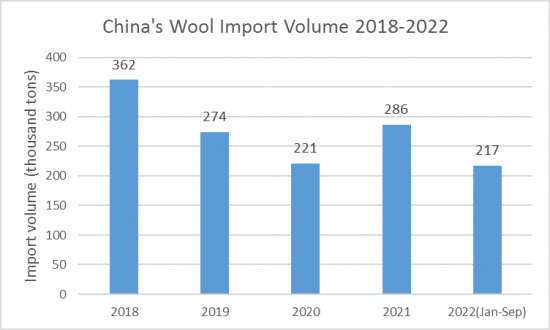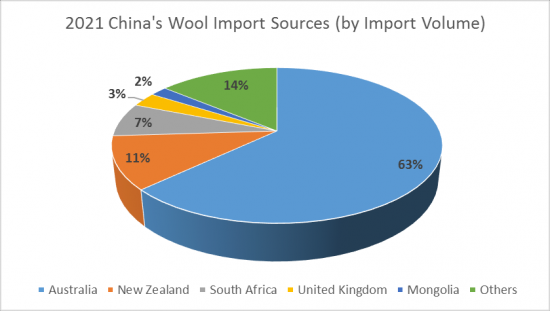 |
市場調查報告書
商品編碼
1162448
中國的羊毛進口的分析 (2023年~2032年)Research Report on China's Wool Import 2023-2032 |
||||||
隨著中國經濟的發展和生活水準的提高,中國市場中羊毛的需求不斷增加。因為可飼養的土地受限,中國國內的羊毛生產幾乎沒有成長,中國每年進口大量的羊毛。中國是世界最大的纖維、服飾生產國,不過,每年大量進口羊毛等的纖維原料。
樣本圖


中國是世界最大的羊毛消費國,隨著羊毛需求增加,中國國內的羊毛生產量趕不上加工市場需求,結果中國的羊毛進口量擴大,進口依賴度慢慢高漲。從2023年到2032年,中國預計持續進口羊毛。
本報告提供中國的羊毛進口市場相關分析,整體進口量、進口額和主要的進口處 (2018年~2022年),各種類的詳細趨勢,進口價格的轉變,主要的推動及阻礙市場要素,主要企業的簡介與策略,今後的進口趨勢預測 (2023年~2032年)等彙整資訊,為您概述為以下內容。
目錄
第1章 中國的羊毛進口的分析 (2018年~2022年)
- 中國的羊毛的進口規模
- 中國的羊毛的進口量
- 中國的羊毛的進口額
- 中國的羊毛的進口價格
- 中國的羊毛的表面消費量
- 中國的羊毛的進口依賴度
- 中國的羊毛主要的進口商
- 進口量
- 進口額
第2章 中國的未梳理、未脫脂剪毛的進口分析 (2018年~2022年)
- 進口量
- 進口額
- 進口價格
- 進口依賴度
- 進口商
- 進口量
- 進口額
第3章 中國的未梳理、脫脂剪毛的進口分析 (2018年~2022年)
第4章 中國的未梳理、炭化羊毛的進口分析 (2018年~2022年)
第5章 中國的羊毛主要的進口商的分析 (2018年~2022年)
- 來自澳洲的羊毛的進口分析
- 來自紐西蘭的羊毛的進口分析
- 來自南非的羊毛的進口分析
- 來自英國的羊毛的進口分析
- 來自蒙古的羊毛的進口分析
- 來自其他國家的羊毛的進口分析
第6章 中國的羊毛進口預測 (2023年~2032年)
- 中國的羊毛進口的影響因素
- 有利的要素
- 不利的要素
- 中國的羊毛進口的預測 (2023年~2032年)
- 進口量的預測
- 進口量的預測:各主要的進口商
- 進口量的預測:各主要的類型
With the development of China's economy and rising living standards, the demand for wool in the Chinese market is on the rise. Due to the limited arable land, there is little room for growth in China's local wool production, and China needs to import a large amount of wool every year. China is the world's largest producer of textiles and clothing. China imports large quantities of textile materials such as cotton and wool every year.
SAMPLE VIEW


In 2021, China imported 286,000 tons of wool (uncombed wool, the same below), up 29.2% year-on-year, and the import value was US$2.40 billion, up 47.9% year-on-year. 217,000 tons of wool were imported into China in the first three quarters of 2022, down 3.8% year-on-year, and the import value was US$1.73 billion, down 8.8% year-on-year.
The average price of China's wool imports fluctuates slightly in 2018-2022, with a relatively stable average price of wool imports in 2018-2019 and a decline in 2020 to US$7.3 per kg, down 16.1% y-o-y. According to CRI analysis, the average wool import price rises to US$8.4 per kg in 2021, up 14.5% y-o-y. The average wool import price falls again to US$8.0 per kg in the first three quarters of 2022.
The main types of wool imported into China are uncombed fat-bearing sheep's wool, uncombed degreased sheep's wool (uncarbonized) and uncombed carbonized wool. In 2021, China imported 244,000 tons of uncombed fat-bearing sheep's wool, accounting for 85.4% of total imports and US$2.32 billion, or 96.7% of total imports in that year.
The main types of wool imported into China are uncombed greasy shorn wool, uncombed degreased shorn wool (uncarbonized) and uncombed carbonized wool. In 2021, China imported 244,000 tons of uncombed greasy shorn wool, accounting for 85.4% of total imports and US$2.32 billion, or 96.7% of total imports in that year.
In 2021, China imported wool from 38 countries. According to CRI's analysis, China's major sources of wool imports by volume are Australia, New Zealand, South Africa, the UK and Mongolia, with wool imports from these five countries accounting for more than 85% of total imports. In 2021, China imported 181,000 tons of Australian wool, accounting for 63.3% of total imports and US$1.89 billion, or 78.9% of total imports that year.
China is the world's largest consumer of wool, and with increasing demand for wool, China's domestic wool production levels have been unable to meet processing market demand, resulting in an expansion of China's wool imports and a gradual increase in import dependence. CRI expects China to continue importing wool from 2023-2032.
Topics covered:
- China's Wool Import Status and Major Sources in 2018-2022
- What is the Impact of COVID-19 on China's Wool Import?
- Which Companies are the Major Players in China's Wool Import Market and What are their Competitive Benchmarks?
- Key Drivers and Market Opportunities in China's Wool Import
- What are the Key Drivers, Challenges, and Opportunities for China's Wool Import during 2023-2032?
- What is the Expected Revenue of China's Wool Import during 2023-2032?
- What are the Strategies Adopted by the Key Players in the Market to Increase Their Market Share in the Industry?
- What are the Competitive Advantages of the Major Players in China's Wool Import Market?
- Which Segment of China's Wool Import is Expected to Dominate the Market in 2032?
- What are the Major Adverse Factors Facing China's Wool Import?
Table of Contents
1. 2018-2022 China's Wool Import Analysis
- 1.1. China's Wool Import Scale
- 1.1.1. China's Wool Import Volume
- 1.1.2. China's Wool Import Value
- 1.1.3. China's Wool Import Price
- 1.1.4. China's Apparent Wool Consumption
- 1.1.5. China's Wool Import Dependence
- 1.2. China's Main Sources of Wool Import
- 1.2.1. By Import Volume
- 1.2.2. By Import Value
2. 2018-2022 China Import Analysis of Uncombed Greasy Shorn Wool
- 2.1 Uncombed Greasy Shorn Wool Import Volume
- 2.2 Import Value of Uncombed Greasy Shorn Wool
- 2.3 Import Price of Uncombed Greasy Shorn Wool
- 2.4 Import Dependence of Uncombed Greasy Shorn Wool
- 2.5 Import Sources of Uncombed Greasy Shorn Wool
- 2.5.1. By Import Volume
- 2.5.2. By Import Value
3. 2018-2022 China Import Analysis of Uncombed Degreased Shorn Wool
- 3.1 Import Volume of Uncombed Degreased Shorn Wool
- 3.2 Import Value of Uncombed Degreased Shorn Wool
- 3.3 Import Price of Uncombed Degreased Shorn Wool
- 3.4 Import Dependence of Uncombed Degreased Shorn Wool
- 3.5 Import Sources of Uncombed Degreased Shorn Wool
- 3.5.1. By Import Volume
- 3.5.2. By Import Value
4. 2018-2022 China Uncombed Carbonized Wool Import Analysis
- 4.1 Uncombed Carbonized Wool Import Volume
- 4.2 Import Value of Uncombed Carbonized Wool
- 4.3 Import Price of Uncombed Carbonized Wool
- 4.4 Import Dependence of Uncombed Carbonized Wool
- 4.5 Import Sources of Uncombed Carbonized Wool
- 4.5.1. By Import Volume
- 4.5.2. By Import Value
5. 2018-2022 Analysis of the Main Import Sources of Wool in China
- 5.1. Analysis of Australian Wool Import
- 5.2. Analysis of New Zealand Wool Import
- 5.3. Analysis of South Africa's Wool Import
- 5.4 Analysis of British Wool Import
- 5.5 Analysis of Mongolia Wool Import
- 5.6 Analysis of Other Wool Import
6. Outlook for China's Wool Import, 2023-2032
- 6.1 Factors Affecting China's Wool Import
- 6.1.1 Favorable Factors
- 6.1.2 Unfavorable Factors
- 6.2. China's Wool Import Forecast, 2023-2032
- 6.2.1 Import Volume Forecast
- 6.2.2. Major Import Sources Forecast
- 6.2.3. Major Imported Wool Types Forecast








